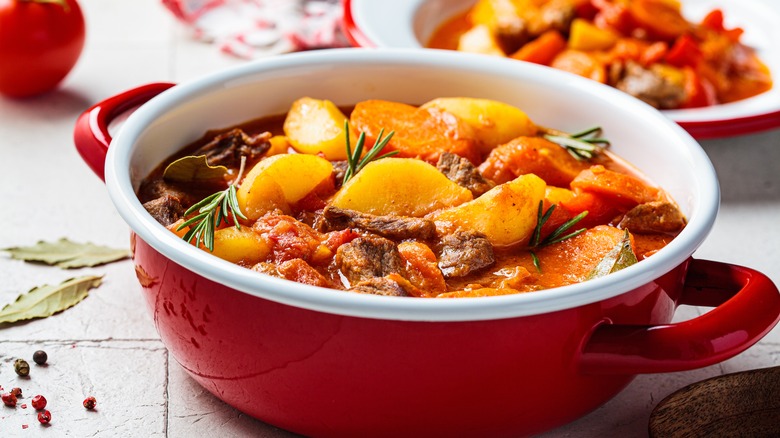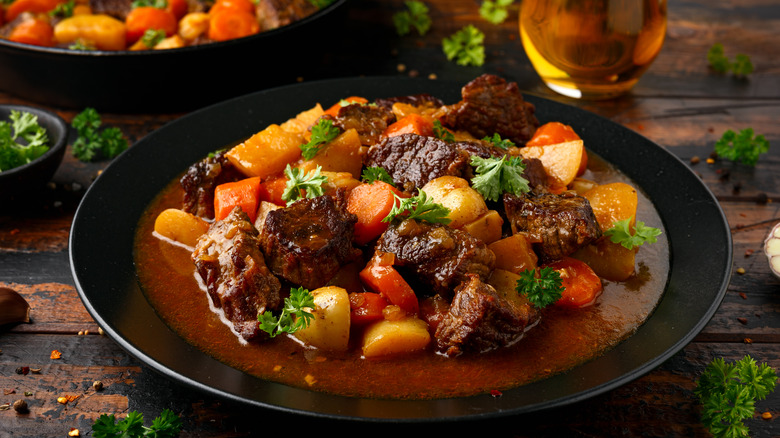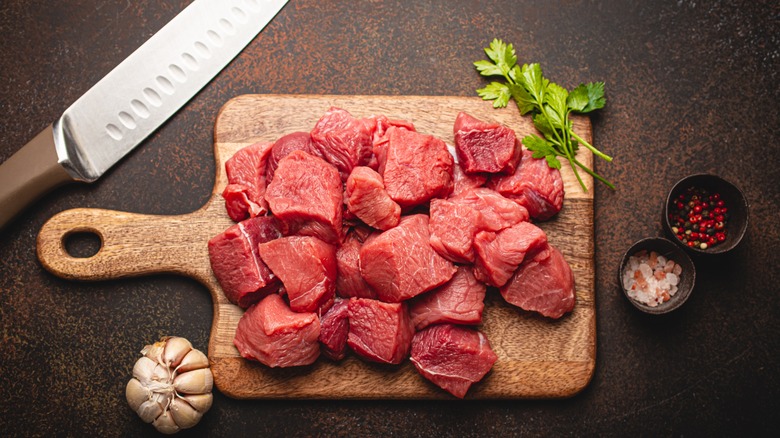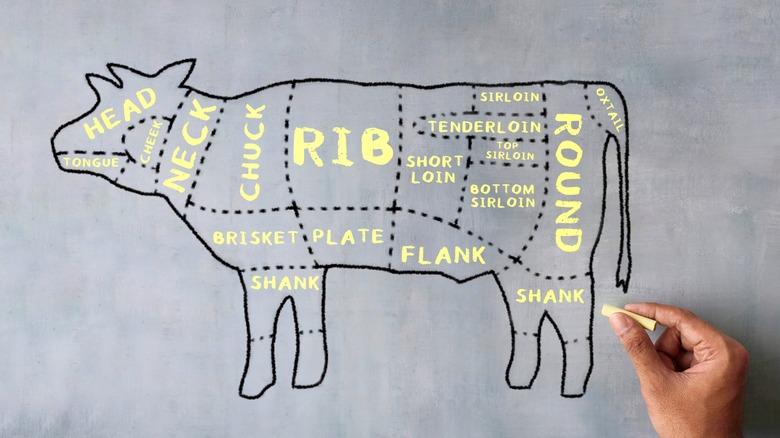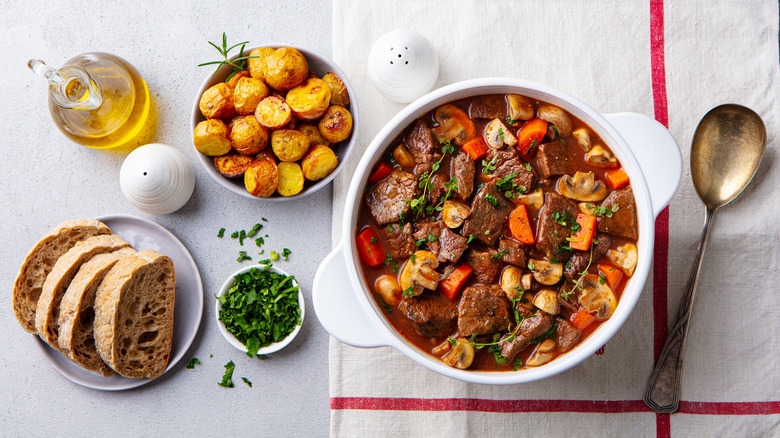The Best Type Of Meat To Use For Beef Stew
You want to make beef stew — great! Luckily, a number of recipes are easy to make. It's a delicious, one-pot meal that feeds a lot of people. What's best is that most beef stews taste even better as leftovers. The first thing to decide is what kind of beef you're going to use. There are many cuts of beef that are good in a beef stew recipe and some that don't work as well (via MasterClass).
Some stores have pre-cut beef cubes packaged and labeled "beef for beef stew," but you might want to ask what kind of cut it is before buying. According to Steak School, your initial instinct may be to buy the most tender beef you can get your hands on because that's the end goal -– to have tender chunks of beef in your stew. Actually, the ideal cuts of beef for stewing are the tougher ones that have a lot of connective tissue and just a little fat. These contain collagen, which is really tough and chewy when uncooked, but after a nice, long simmer, it slowly breaks down and adds flavor and depth to the stew. As a result, the tough chunks turn tender and juicy, exactly what you're looking for!
Classic, tasty beef stew
You might ask, "Can I just grab a few steaks, cube them up, and use those?" They are great cuts of beef, but according to the National Cattlemen's Beef Association, they are better for grilling and braising whole. Making beef stew requires browning your beef and then simmering it for a few hours. Simmering those already-tender cuts in a pot of stock and vegetables for that long will dry them out and turn succulent steak bites into chewy shoe leather bites. The last thing you want is to try to gnaw through tough, dried-out pieces of meat!
According to MasterClass, the best cuts to use are some of the tougher cuts. It sounds counterintuitive, but these tougher cuts that have a much lower fat content are loaded with connective tissue that contain collagen. As the great Julia Child once said in an interview with Esquire, "Fat gives things flavor." The lower fat content of these cuts really adds flavor to the stew without adding so much fat that you eventually have to skim it off the top. They also become more tender the longer they simmer.
Which cuts to use
With so many great options to choose from, it can be confusing when picking out the best beef for your stew. One cut that Gordon Ramsay feels is underrated is brisket. It comes from the lower chest and is wonderful when turned into pastrami or southern-style BBQ. "The key to beef brisket is to cook it low and slow to make it tender," says Ramsay in a video on his official YouTube channel. It's also a very affordable cut of beef.
Jamie Oliver's beef of choice for French beef stew is beef cheeks. It's a cut that is a little more difficult to find, but definitely worth it. The British chef says he likes this for stew because of all the sinew it contains, which is terrible in a steak, but when slow-cooked, it "...is a gift, and it just slowly melts away, giving you unbelievable textures" (via Oliver's official YouTube channel). He likes to serve it with fresh greens and mashed potatoes.
Another great option, as championed by J.Kenji López-Alt, cookbook author and YouTube chef, is using a chuck roast. In a beef stew video (on his official YouTube channel), he says that what makes this cut so great for stew is all the marbling. The "fat and connective tissue are going to keep it juicy as it cooks, cause even though you're cooking in moisture, it can dry out." According to BBC Good Food, chuck roast is among the more affordable cuts of beef and is easy to find.
Other possibilities
There are other cuts that can be applied to beef stew (via the National Cattlemen's Beef Association). Sirloin and eye of round are great inexpensive choices that are nice for stewing and braising. These tougher cuts come from the lower back and the hind legs of the cow, respectively, and are easy to find.
Another cut you might want to consider is oxtail. It's a more expensive cut from the tail (yes, the actual tail) that isn't always available, but totally worth it if you can find it. Using oxtail requires patience because it takes a long time to cook, and there are bones to deal with before you serve. But the results will be "amazing delicious once braised out," according to an interview with James Piesker, co-owner of Porter Road, a Nashville butcher shop. He describes oxtail as one of the more used muscles of the cow that requires a lot of work, but "once you get that meat out of there and the braising liquid, that days' worth of work is all worth it." (via Andrew Rea's official YouTube channel). Oxtail stew, anyone? Yes, please!
Fancy it up
If you want to really impress people and maybe spend a little more to make the dish a little fancier, certain cuts will enhance the flavor of your stew and take it to a whole new level.
According to an interview with Ina Garten on NPR, her go-to meat for stew is chuck, but a great way to spruce it up is by using short ribs. "When they stew for a long time, they flavor the sauce," she says. She also recommends adding some red wine and cognac, the way the French version typically calls for in beef bourguignon.
This is the decadent, melt-in-your-mouth flavor bomb you didn't know you were missing! In fact, after making your first beef bourguignon, you might just decide to cook your way through Julia Child's "Mastering the Art of French Cooking" and blog about it (a la "Julie & Julia")!
There are many cuts of beef that can be used for beef stew, so try out a few different options to decide which one you prefer. Choose your beef stew meat carefully and enjoy!
